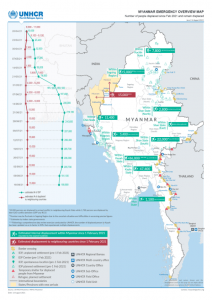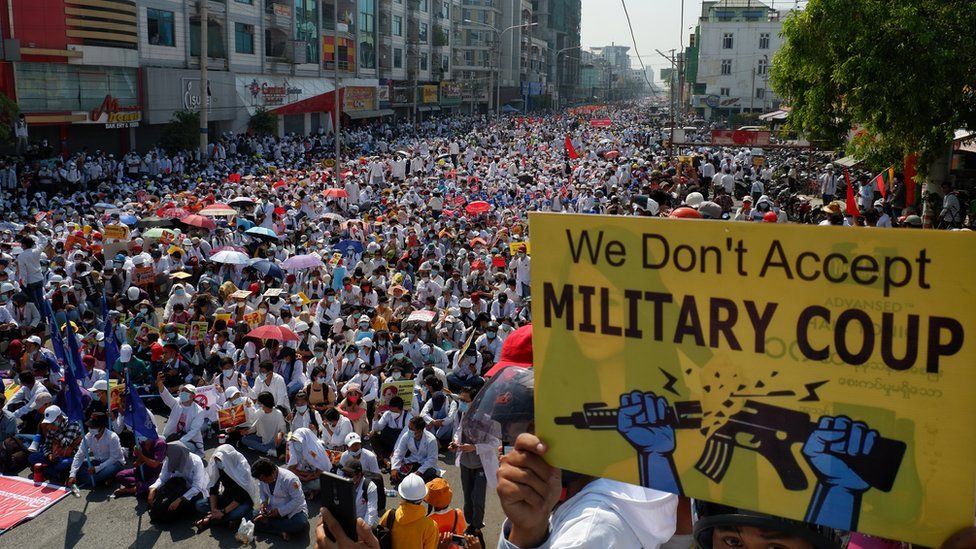Background
Although Myanmar’s GDP growth rate already began declining back in 2018, the covid-19 pandemic proved a critical blow to the country’s economy. The disruption of national and international supply networks together with lockdowns, travel restrictions, and labor shortages have severely hindered the country’s efforts to reduce poverty. While the brutality of the military following the February 2021 coup has naturally raised human rights concerns, leading to massive protests and international condemnation, the negative effects of the coup on the livelihoods of millions of people in Myanmar are equally alarming.
Food security
Before to the coup, 2.8 million people suffered from food insecurity in Myanmar. The WFP has warned that 3.4 million more people may become food insecure in the upcoming months. Myanmar is mainly an agricultural country; approximately 70% of its population works in this sector, divided into crop production, fishing and livestock. Recurring natural disasters have long impacted farming, but the disruption of supply chains and transportation caused by the onset of covid-19 was an economic shock that came in the form of shrinking demand and reduced exports. Therefore, by the time the February 2021 coup took place, the sector had already been shouldering the effects of covid-19 for months, although the military coup made the situation even worse.
Workers across the country have been going on strike to join Civil Disobedience Movement (CDM), including those engaged in the banking sector in charge of supporting farmers through loans and microcredits. In addition, operational banks have also been delaying loans. Seeing as 80% of the farms in Myanmar are run by smallholder farmers, the sudden lack of access to these mechanisms could threaten the sustainability of their livelihoods. Irregular bank services also means millions of migrant workers are unable to send money back to families in Myanmar, who may rely heavily on these remittances to survive.
The uncertainty derived from the coup has also led to rapid inflation and price hikes. Just recently, in September 2021, Myanmar’s currency hit a record low of around K2,500 to USD. Some of the commodities most affected include essential farming products such as pesticides and fertilizers, as well as basic household items such as rice and cooking oil. Given the importance of these items, increased price hikes will worsen food security for households – especially those that include vulnerable groups like children and pregnant women. Currently, 28% of children between 0-59 months in Myanmar are stunted, while 7% suffer from child wasting. 40% of reproductive age women in Myanmar also experience anaemia during pregnancy.
Furthermore, the military junta is no stranger to cutting off food supplies to conflict-affected areas in order to weaken ethnic armed organizations’ (EAOs) capabilities. Since the 1960s, the military has adopted a “four-cuts” strategy during certain military incursions that involves restricting access to food, funds, intelligence and recruits.
Displacement
At the beginning of 2021, it was estimated that more than 370,000 people were internally displaced in Myanmar. The exact displacement figures remain unknown, as people are frequently on the move and escalating security concerns make it difficult to obtain reliable data. The UNHCR also estimated in 2018 that there were about 1,1 million refugees hailing from Myanmar across the world. As of September 2021, more than 200,000 new people have been displaced since the February coup due to armed clashes between the military and ethnic armed organizations. The areas most affected include Kayah, Kayin and Chin states as well as southern Shan. Many displaced people do not have access to adequate shelter and have been forced to live in makeshift tarps in the middle of the jungle, with limited or no access to other key services such as healthcare and food. Save the Children estimates that 76,000 children have been displaced due to the February 2021 coup.

Source : UNHCR Myanmar Emergency Overview Map
Internally-displaced people are also especially vulnerable to forced recruitment, human trafficking, and difficult weather conditions such as heavy monsoon rain, which in turn has further difficulted aid distribution by INGOs.
Furthermore, people displaced by the coup not only have suffered mental and physical hardship, but have also been robbed of their main sources of income: land. The use of bombs and landmines has either made it impossible for certain people to farm their land or prevented them from even trying out of fear they’ll be targeted, as cases of rape and murder committed by military officers surface.
Moving forward
Many have started warning Myanmar has – or will shortly – become a failed state. The country’s economic collapse may have begun with the arrival of covid-19 and the government’s inability to adequately handle an unprecedented pandemic, but the coup was the final blow. Increasing armed confrontations, displacement, disrupted supply chains, limited financial aid and currency depreciation have shattered growth prospects and paint a bleak picture of households’ livelihood development in the near future. Given the military junta’s blatant disregard for the 5-point consensus reached by ASEAN in April 2021, which included the immediate cessation of violence in Myanmar, it seems the military is in no rush to guarantee the safety and economic resilience of the people of Myanmar, especially for those belonging to ethnic minority states.
Featured Image – Getty Images

